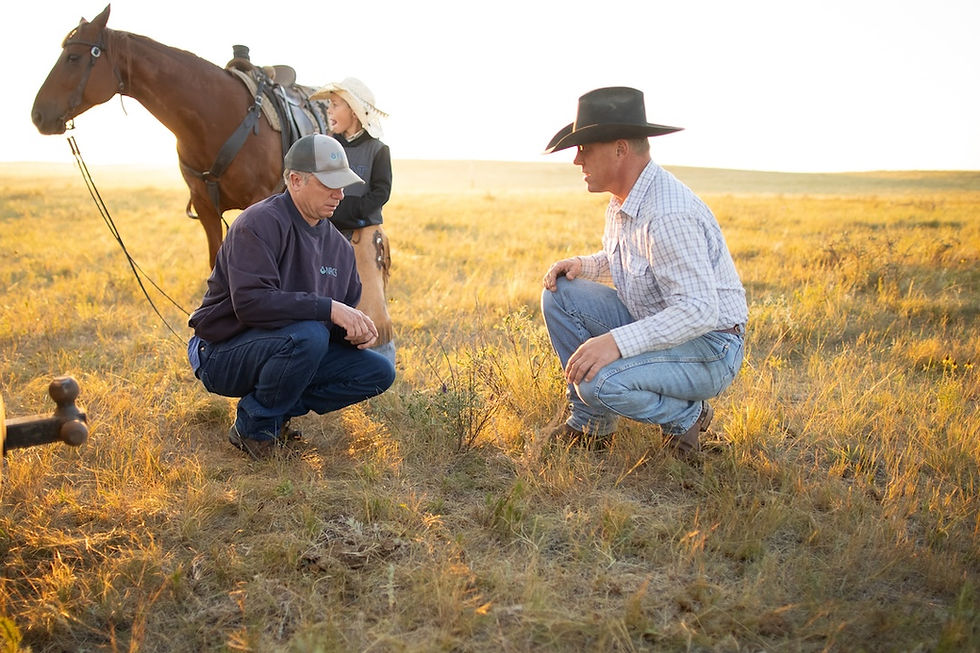This Prairie Plant Identification Tour Could Change your Life
- Buz Kloot, Ph.D.

- Jun 1, 2023
- 3 min read
Updated: Jul 7, 2023
Recognizing and Nurturing a Diversity of Prairie Plants can bring Resilience and Profits

By: Buz Kloot
I’m not going to lie. Three years ago, I was a Prairie ignoramus. As a scientist, I had fallen in love with soils, but focused on row cropping systems. My world began to change when my work led me to learning from South Dakota ranchers and NRCS-SD grazing land specialists.
The first thing that I was made aware of was that we are losing prairie habitat. Yes, the obvious losses, to urbanization and conversion to cropland are no-brainers. But there are also spectacular losses to invasive woody species like eastern red cedar––take a look next time you drive past Chamberlain along the Missouri River.
Silent Invaders
But what really made an impression on me is the huge loss in productivity and resilience that has come from vanishing prairie plant diversity as prairie pastures are overrun by smooth brome, Kentucky bluegrass, and crested wheatgrass. I realized the loss was staggering when I started seeing this for myself. It is insidious; if you drive along the road and don’t stop and look between your feet, you’ll never know how prolific and damaging these silent invaders are.
Had I not been educated by my NRCS and rancher friends, I would have remained ignorant and would have sleepwalked my way through the prairie. Of course, it’s much more important to a rancher than it is to me to recognize and nurture the prairie plants on their land. As rancher Candice Mizera says, “Well, 15 or 20 years ago, I’m not sure what the pasture was composed of because I didn’t know the differences; I knew we could do better, be more resilient and more profitable, and we needed to figure it out. Even today, I still feel don’t know a lot, there's just so much more to learn.”
If your pastures are overrun by invasives that don’t last through the grazing season, and you don’t have the healthy, productive pastures you know you could have, you can begin to learn the makeup and value of diverse prairie pastures at the “Good, Bad, and Similar Looking Plant Tour” near Veblen, South Dakota on June 15.
Even if Veblen, is a little out of the way, I really recommend you make the effort to attend this tour that’s offered by the South Dakota Grassland Coalition. It’s from 10 a.m. to 3:30 p.m. I do have Grassland Plants of South Dakota and the Northern Great Plains on my bookshelf, and I have made a good faith effort to read through the book. But the fact is that there is nothing that substitutes for a hands-on tour that allows you to look down, see, touch and smell the prairie plants, good, bad and indifferent.
Why do I say these 5½ hours could change your life? I say that because knowing what plants are in your pastures is the first step in managing them for higher productivity and profit. The tour will show you first hand that the plants you see in a prairie are an expression of how the land is managed (rotation, rest, recovery, varying times of usage).
I have spoken to producers who have more than doubled their productivity on the land and to a person, they attribute observation––recognizing the makeup of their pastures and managing for diversity. During the tour, ranchers and grassland specialists will explain the tools you need to observe the land and better understand whether a particular pasture is going forward or backward.
Oh, by the way, this life-changing tour is free, but the organizers would appreciate an RSVP.
Here’s a link to the flyer.
Editor’s note:
Dr. Robin “Buz” Kloot is a Research Associate Professor at the University of South Carolina. He has been working with the USDA/NRCS and grassland producers in South Dakota to improve soil health on cropland and more recently grasslands.
____________________________________________________________________
Visit these “Growing Resilience Through Our Soils” information pages:
1. Podcast page for drought planning fact sheets, Q&As, news, podcasts and more.
2. Video page to watch videos of other ranchers’ journeys toward improved rangeland/pasture.
3.Follow Growing Resilience on social media:
4. Our homepage: www.growingresiliencesd.com





Comments